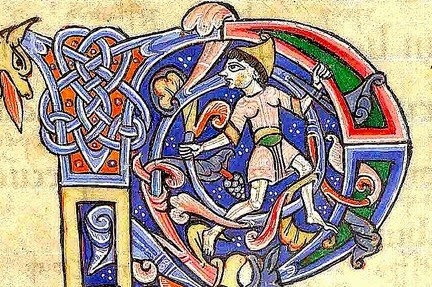1. The hood. Which hasn't developed the liripipe yet.
Fecamp psalter from Flanders. A peasant rakes down acorns to feed the swine.
Note the embroidered decoration on his hood.
Interesting is also his legwear, since he has boots, but no hose.
Another one from the same manuscript:
I actually use this one for teaching, but only to show the harrow, which is a medieval invention.
He also lacks hose and his hood is checked with white edges as decoration.
In the Fecamp psalter you also see the cucullus, a hooded closed cloak known since Roman times in Gallia. But that's not mainly headwear I guess.
2. The coif
While more commonly seen in the 13th and early 14th century the coif probably has its origins in the 12th century; first worn to protect the hair against a maille hood, but soon spreading to other social circles and circumstances. Again there are nice examples from the Fécamp Psalter.
As you see there are embroidered decorations on the coifs. Very nice.
A German manuscript of Gregorius' Moralia in Job. Also with some decor around the edges.
And here's a green one, also from Moralia in Job, but an English manuscript this time.
From Spain we also find a preserved example from the 12th century
3. The Phrygian cap. Known since Ancient times and very popular in the 11th and 12 th centuries.
Geoffrey Plantagenet, count of Anjou has the prettiest one:
Embroidered with a lion and everything!
But you find them in lots of manuscripts.
This is a lovely one from a French manuscript.
A French glass painting
And a few German ones:
This is from a lovely manuscript from Münich, from the very end of the 12th century.
And some English Phrygian caps
This one is from the late 11th century:
And you see a Phrygian cap among some round hats behind the ladies here in the Hunterian Psalter:
As you see sometimes you can see the curved shape of the cap and sometimes they just draw a triangle. This may represent different types of cap, but may also be a style of painting. or even the same type of cap made from different fabrics, where a stiff fabric won't fold over the way a thinner fabric does.
Sometimes it is hard to discern the Phrygian cap from the next type: the round cap. Realism wasn't always the primary goal for the illuminators.
4. Round caps
The Hunterian Psalter has more examples of round caps than the one shown above, like these:
The ones to the left look like proper hipster caps.
Just like the Phrygian caps (and coifs) the round caps could be decorated.
The guy in the middle has an interesting cap. Chartres.
Fécamp Psalter again, of course:
The two-faced look may be hard to take after
Or turned up in this sassy way
5. Hats to protect against the sun, probably from straw.
The Fécamp psalter has some lovely hats that probably ar emade from straw, but sicne they are decorated, maybe with paint, you can't be certain.
Finally there is this type of hat, which was used to designate Jewishness in paintings.







..jpg)


























best headwear needytoday.com
SvaraRadera